Abstract
During the late 1970s and early 1980s, the German nuclear power industry came under considerable socio-political pressure from the growing environmental and anti-nuclear movement. As part of a diversified public relations strategy, the Kraftwerk Union (KWU, later Siemens) as the main manufacturer of nuclear power plants distributed pre-printed QSL cards to amateur radio enthusiasts. These cards carried images of the latest nuclear power plants built by KWU. This paper examines the history, iconography and distribution of these QSL cards in the context of the heritage of the German nuclear power industry. It is the first study of its kind to examine the heritage significance of QSL cards.
1. Introduction
There is a considerable body of literature that examines the production [1] and consumption of picture postcards and the messaging their imagery contained [2,3,4,5,6,7,8,9,10]. The image selection and framing of postcards, through their stereotyping of landscapes, points of view, infrastructure and developments, conveys political messages to the viewer, messages that the audience of the time would have well understood [5,11,12].
Picture postcards were commercially produced, made available for purchase at stationers, hotels and souvenir vendors and could be sent either openly through the mail or enclosed in letters. Picture postcards, which were developed in the late 19th century, soon become collectible items, both signaling the status of the sender and recipient (where sent through the mail) and the status of the collector where shown in display books [1]. While essentially ephemera, picture postcards have become a source of historic information [13].
Unlike picture postcards that were commercially produced in large quantities, there is another group of postcard-like ephemera, which have not yet seen any attention from historians and heritage professionals: QSL cards. These will be the focus of this paper.
1.1. QSL Cards
QSL cards are used by amateur short-wave radio operators, as well as by commercial radio stations, to formally acknowledge that their station has been heard by another party [14]. The early QSL cards carried the call sign in large letters as well as text identifying the station and they were augmented, on occasion, by a graphic image. Since the mid-1960s, QSL cards tended to carry fully designed front views with pre-printed fields for technical data on the verso side. The imagery shown is usually a portrait of the user, the user’s equipment and set-up, their pets or, quite commonly, an attraction of the local area [15]. While at first sight many of these QSL cards resemble standard picture postcards, they differ in one fundamental way: postcards provide a representation of key attractions which already have or are in the process of attaining icon status, inducing tourists to visit these sites and then to reinforce the icon status by replicating the pictorial messages through postcards and their own images for personal or public consumption (in on-line blogs, Facebook or Instagram) [10,13,16,17,18]. In this scenario the user or sender of the card exerts some editorial control through selection of the commercially available cards for use [18]. The motifs of the QSL cards, on the other hand, are highly personal and usually designed, or at the very least consciously selected, by the user [19,20]. Moreover, the operator will use the same card design for a considerable period of time, or at least until the print-run has been exhausted. Unlike postcards that are carried openly through the mail, and where the visual messaging, as well as the text, is accessible to every individual handling the mail along the way, the QSL card imagery is, in the main, only seen by the sender and the receiver as most QSL cards were sent in envelopes. Thus, while the imagery chosen for the QSL cards is characterized by ideological messaging akin to that of the production of postcards [10,13], it is solely reflective of that radio station owner’s interests and ideologies.
1.2. The Cultural Heritage of Amateur Radio
The use of QSL cards is intertwined with the history and heritage of commercial and government-operated shortwave radio stations. That heritage has been considered from various angles, such as technology [21,22,23], ideology and propaganda [24,25,26,27], military uses [28] and national interests [29,30,31]. There are limited studies that examine the history of amateur (‘ham’) radio [32,33,34,35], with the several papers focusing on the perception of individually owned radios as a threat to national security [36,37]. While now a largely replaced by internet based digital communications, amateur radio, rather than becoming an obsolete technology, has seen a resurgence in popularity [38]. Indeed, government instrumentalities have considered it as a redundant communications channel in emergency situations [39,40]. From a heritage perspective, amateur radio has seen much less attention, primarily, because the constituent components tend to be privately owned and, with the exception of roof- or mast-mounted antennas, are objects of moveable heritage, Moreover, these were continuously upgraded while obsolete components were sold or discarded. A number of smaller collections of amateur radio equipment exist, such as the Asheville Radio Museum (Asheville, NC, USA) [41], the ARRL Heritage Museum (Newington, CT, USA) [42], the Antique Wireless Museum (Bloomfield, NY, USA) [43] or the Kurrajong Radio Museum (Kurrajong NSW, Australia) [44]. While collections of equipment are important as they demonstrate the technological developments and capabilities at the time, the true global significance of the amateur radio only becomes evident when we consider the multitude of inter-personal networks that these created and the often cross-cultural exchange that they entailed. Retrospectively, these networks can only be documented and illustrated by means of the QSL cards, which are documentary evidence of a successful two-way communication. As will be discussed below, there are QSL card archives, such as that of the ‘Assoziation Deutschsprachiger Kurzwellenhörer’ (Mönchengladbach, Germany) and the ‘Dokumentationsarchiv Funk’ (Vienna, Austria).
This is the first study of its kind to examine QSL cards featuring nuclear power plants and to situate these cards in the discourse of communication management and political messaging. This paper will discuss a series of German QSL cards which carry the motifs of nuclear power plants, by examining their history, chronology and nature of production and their extent and mode of distribution. The paper concludes with a discussion of the underlying motivation for their production.
2. Methodology
The card images were sourced through systematic online searches using text-based searches in German, English and French (e.g., ‘Kernkraftwerk + QSL’; ‘nuclear power + QSL’) on the general WWW, on-line auction houses such as eBay, hood.de and Delcampe and sales platforms such as Amazon and Etsy. Image aggregator sites such as PicClick (http://picclick.com accessed on: 27 June 2021) allow ready access to such images and through these, to the original listings. Once images had been identified, further examples could be located using image matching software provided as part of the search function of Google images (https://images.google.com accessed on: 27 June 2021). In addition, direct contact was made with QSL card archives [45] and postcard collectors [46] as well as individual amateur radio operators who had posted images on their websites. In total 110 individual cards could be compiled and analyzed. These cards have been catalogued and documented elsewhere [47]. While the location of the sender of the QSL card is usually printed in the card itself, the location of the recipient could be established through the QRZCQ database (https://www.qrzcq.com accessed on: 27 June 2021).
QSL Card Collections
Although a printed matter, QSL postcards are ephemera and as such are not systematically collected by the German National Library [48,49] or other national or state institutions in Germany [50]. Given that they are highly personal productions, they also are unlikely to be included in the collections of local museums and local government archives. Even if some cards were included, none of these smaller collections are readily or centrally accessible. It can further be assumed that examples of QSL cards with images of nuclear power plants might be held by the archives which are maintained by the individual operators of the nuclear power plants, but these archives are generally not accessible to external researchers [51].
While there are some websites that show larger collections of German QSL cards [52,53,54,55,56], none of these are systematic collections or have a reach beyond that of the individual user. It is therefore difficult to gauge absolute frequencies of design motifs and trends over time. Some level of frequency can be gauged by the fact that among approximately 30,000 QSL cards accumulated by one collector, only 14 carried a motif featuring a nuclear power plant [46]. The archive of the ‘Assoziation Deutschsprachiger Kurzwellenhörer’ (ADXX) in Mönchengladbach contains in excess of 20,000 QSL cards and none carry a motif with a nuclear power plant [57]. The most comprehensive collection and archive is the Vienna-based ‘Dokumentationsarchiv Funk’ which holds some seven million QSL cards in its collections. The vast majority of these cards have never been digitized and are only indexed according to the station code [58], thus making it impossible to estimate their total ‘market’-share and reach. A few QSL cards with images of nuclear power stations in that collection have been digitized and could be drawn on [45].
3. German Nuclear Power—An Overview
Following World War II, the Allies had declared nuclear technological research to be part of weapons research and it remained forbidden under the laws passed by the occupation forces [59,60,61]. The political path to the (West) German nuclear program was paved when the Federal Republic of Germany (BRD) signed a bilateral treaty with the USA which permitted West Germany to acquire enriched U-235 from the USA and allowed German companies to gain access classified information on nuclear power plant design [62]. The new confidence also allowed the universities of Munich, Frankfurt, Berlin and Hamburg to acquire small US-built research reactors in 1957 [63], all of which went operational in 1958. The Forschungsreaktor München, a reactor of the swimming pool design built by AMF Atomics [64], was first to go critical on 31 October 1957 [65].
The German Democratic Republic (DDR), which was subject to the rulings of the Soviet Military Administration, had lost a number of nuclear physicists and chemists who had been captured to work with the Soviet Union on the development of nuclear technology [66]. The East German nuclear physicists’ gradual return in 1954/55 allowed the DDR to advance its own nuclear energy program [66]. A bilateral agreement (in 1955) between the DDR and the Soviet Union enabled the DDR to develop technology, but also tied it to the WWER-type reactor lines that were being designed and deployed in the Soviet Union [67]. Its first electricity-producing nuclear power plant, at Rheinsberg, went critical on 11 March 1966 and started commercial production on 11 October 1966 [68]. When the need for a nuclear power station was reaffirmed in 1965, the USSR was interested in a more autonomous development in the DDR, but the DDR government was keen on turn-key solutions rather than investing in part or fully self-designed developments [69], leading to the delivery of Blocks 1 to 4 of the KKW Nord at Greifswald [66,69,70].
The commercial success of the US nuclear reactor industry with the boiling water reactor (BWR) concept designed by General Electric and the pressurized water reactor (PWR) concept designed by Westinghouse, coupled with the costs of developing an unproved national German set of reactors types, led the West German energy industry to argue for the adoption and further development of US designs. As a consequence, the two main German companies interested in building nuclear power plants licensed the US designs, with AEG taking up the General Electric’s BWR and Siemens adopting Westinghouse’s PWR. Three ‘demonstration nuclear plants’ were built: Gundremmingen A and Lingen (and later Kahl), all BWR designs built by AEG-GE, and Obrigheim, a PWR design by Siemens-Westinghouse [71]. The first reactor, VAK Kahl, went critical on 13 November 1960 [72]. AEG pursued further developments of the BWR concept with its ‘Baulinie 69’ series of reactors at Brunsbüttel, Isar I, Phillipsburg I and Krümmel, as well as the completed but never activated Tullnerfeld (Zwentendorf) in Austria (Table 1) [73,74]. The PWR designs of Siemens won out, with its ‘Baulinie 72’ (Gundremmingen B and C, and the never completed Projekt Kaiseraugst [73] and successor designs of Baulinie 3 (units Brokdorf, Grafenrheinfeld, Grohnde and Philippsburg 2) and ‘Konvoi’, a.k.a. ‘Baulinie 80’ (units Emsland, Isar 2 and Neckarwestheim 2) [75,76,77,78].

Table 1.
Representation of German Nuclear Power plants on postcards and QSL cards.
In the early 1970s, some community groups increasingly expressed concern about the safety of nuclear power plants and the impact they might have on the environment—A view that was not shared by the political establishment.
While the opposition towards individual AKW initially comprised of the submission of signed petitions, such as a 1974 petition against the construction of KKW Grohnde with 12,000 signatures [79], growing frustration with the political landscape at the time saw an increasing number of direct action events. While the occupation of the construction site for the nuclear plant at Whyl in February 1975 was largely peaceful [80], the demonstration against the start of construction of KKW Brokdorf (13 November 1976), ended in violence, with 79 police and 80 demonstrators being injured [81], as did a demonstration against the start of construction of KKW Grohnde (19 March 1977). At that event, when some 12,000–15,000 protesters were faced by a combined force of 4800 police and border guards, with 240 police and at least 82 demonstrators injured [81,82]. Conflicts escalated at subsequent mass demonstrations at Gorleben (12 March 1976, 20,000 protesters), Kalkar (24 September 1977, 30,000 protesters) and again at Brokdorf (28 February 1981), when an approximate 50,000 demonstrators facing about 10,000 riot police [83]. At the time, the political establishment raised the arguments that the anti-nuclear movement was in fact controlled by far-left ideological forces, thereby aiming to deflect any mass appeal that the environmental movements might attract [81].
It is against this political backdrop that the QSL cards discussed in this paper need to be understood.
4. Types and Chronology of Cards
4.1. Types
There are two types of QSL cards on record: those produced by individual operators and amateur radio clubs (Figure 1 and Figure 2) and cards produced by the Kraftwerk Union and later Siemens) for a number of amateur operators (Figure 3 and Figure 4).
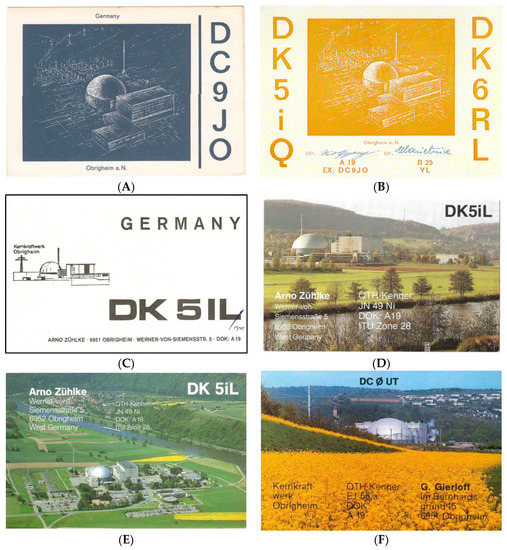
Figure 1.
(A–F) Designs of privately manufactured QSL cards featuring KKW Obrigheim (KWO).
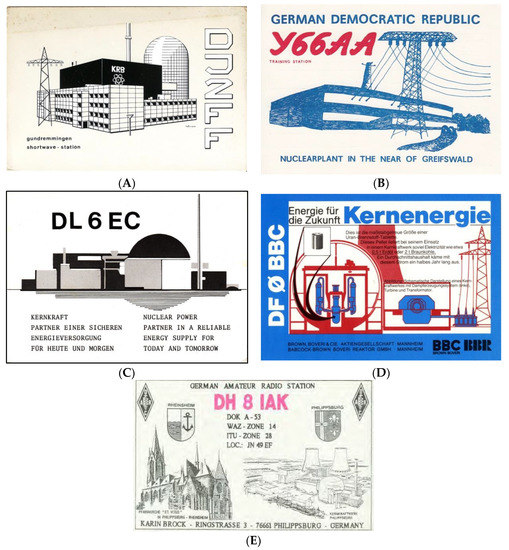
Figure 2.
Designs of privately manufactured QSL cards. (A) KKW Gundremmingen; (B) KKW Greifswald (KGR); (C,D) schematic of a nuclear power plant; (E) KKW Philippsburg.
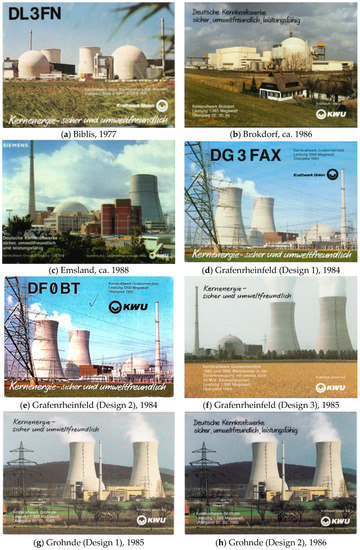
Figure 3.
(a–h) Designs of KWU- and Siemens-sponsored QSL cards.
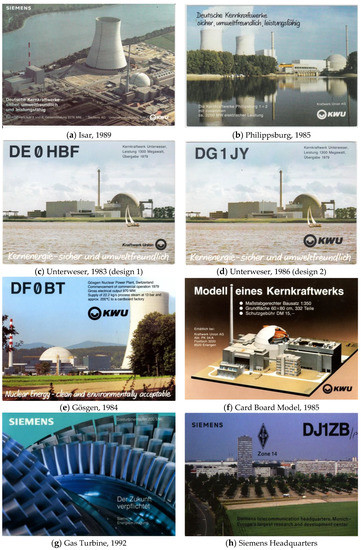
Figure 4.
(a–h) Designs of KWU- and Siemens-sponsored QSL cards.
The overwhelming majority of the cards do not bear imprint dates and thus can only be dated in relative terms. An exception are the cards produced for the Greifswald KKW Nord amateur radio station. These carry imprint dates encoded in the print information on the bottom left of the card verso [84].
4.2. The Designs
The earliest QSL cards featuring nuclear power plants are monochrome-printed cards with line drawn motifs. The increasing use of color offset printing in the late 1980s reduced printing costs and also allowed for smaller print runs to be more economic. While process-color printed front sides of QSL cards became more common, process color printing was still expensive, which made the KWU-provided cards so appealing.
The recto of a standard QSL card tends to show a pictorial image as well as, in most cases, the station’s call sign in prominent lettering. As can be expected, the main motif covers most of the space. Setting aside the KWU-designed cards, only the minority of the individual operator cards has been professionally graphically designed. The others tend to be unbalanced or cluttered designs. Even the card produced by and for Brown Boveri & Cie is cluttered and overloaded with information. Clean and professional designs include the cards for DC9JO, featuring Obrigheim, Gundremmingen as well as the image of a generic power station.
The left half of the verso of the card provides a frame for the transmission data as well as the name and address of the station operator, while the right half, as for post cards, was reserved as the address field. An exception are the two photographic cards that feature Obrigheim. Neither have the customary postal address portion but provide extensive technical data on the KWO nuclear power plant.
The design of early 1971 cards show a sketched perspective view of the nuclear power plant of Obrigheim (Figure 1A,B) as well as Gundremmingen (Figure 2A). For the former, additional examples of the card are on record with dates of 20 December 1970 and 30 January 1971 [46]. On occasion, radio operators felt very strongly about the motifs shown on their designs. We have in hand three designs used by the Obrigheim-based operator of station DK5iL, both featuring KWO Obrigheim. One is a line-drawn card, on record for 1974 (Figure 1C) and the other two are color printed aerial views on record for 1991 (Figure 1D) and 1998 (Figure 1E).
Connected to the electivity grid on 1 April 1969, the nuclear power station of Obrigheim was particularly popular motif, with several operators (Figure 1) [47] Common to these is the fact all these operators either lived in or near the town of Obrigheim itself. The motif of the Obrigheim nuclear power station, nestled behind a hill with a field of yellow rape seeds in the foreground (Figure 1), was used by two operators (DC0 UT and DB2 JE). Common to these full (process) color QSL cards that the verso contains explanatory text about the power station itself.
A black and white drawing of a generic nuclear power station, bearing the slogan “Nuclear power—Partner in a reliable energy supply for today and tomorrow” in both German and English (Figure 2C) is on record for 1978 to 1980. While at least three operators used this card design (DF3 KP, DF3 KT and DL6 EC), all were located within a 10 km radius, suggesting they belonged to the same group.
While the majority of the cards stem from West German operators, one such card originates from an East German radio club which operated under much more strict government control than its western counterparts. The club used a standard card and varied the call sign depending on whether it was used as a training station (Y66AA), the club as a whole (Y66CA), the head of the station (Y66ZA) or individual members (Y66QA, Y66RA). While the other cards are produced in German (an exception being the KWU-sponsored card with the motif of Gösgen), the Greifswald QSL card, designed in 1987 by Sabine Zenker (Greifswald) [84], was published in English—replete with mistakes common to non-native English speakers. Consequently, the card reads “Nuclearplant [sic] in the near of Greifswald” instead of “Nuclear [power] plant near Greifswald” or “Nuclear [power] plant in the vicinity of Greifswald”.
4.3. Chronology
All cards that have been used for chronological analysis show the date of reception, which gives a terminus ante quem for the production. Some cards carry a date on the face of the image that provides a terminus post quem (Figure 5).
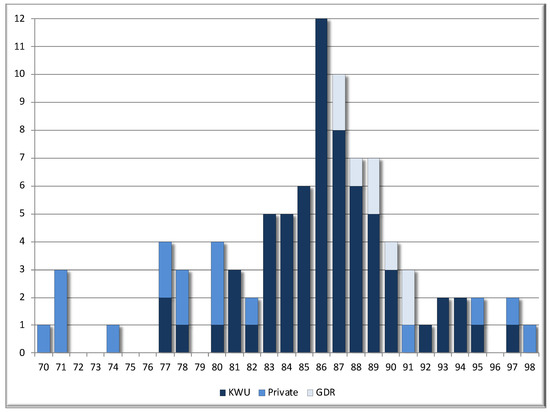
Figure 5.
Annual Frequency of West German QSL cards documented in this study for which dates are available (n = 87).
Given the disparate nature of the data sets, mainly held by individual amateur radio operators, and given that this is the first study of its kind to compile and examine QSL cards with nuclear power plants as the theme, the sample of QSL cards documented and analyzed in this study is comparatively small (n = 110). The chronological representation of the cards, where dated, has been plotted in Figure 5. Given the limited nature of the data set available, this chronological distribution has to be regarded as indicative only.
5. Productions by the Kraftwerk Union
A special case of the QSL cards with photographs of nuclear facilities cards those issued by the German nuclear reactor manufacturer Kraftwerk Union AG (KWU). Their cards were issued from 1977 and made available free of charge to radio operators [85,86,87,88]. The KWU, first created in 1969 by a merger of the nuclear branches of AEG and Siemens, and from 1978 solely owned by Siemens, was the sole manufacturer of nuclear power plants in Germany. The designs of the KWU-sponsored QSL cards feature the nuclear power plants of Biblis, Brokdorf, Emsland, Grafenrheinfeld, Grohnde, Isar, Philippsburg and Unterweser, as well as Gösgen in Switzerland (Figure 3 and Figure 4).
All KWU-sponsored QSL cards carry one of two slogans: “Kernenergie—sicher und umweltfreundlich” (‘Nuclear energy—safe and environmentally friendly’; Slogan A) and “Deutsche Kernkraftwerke—sicher, umweltfreundlich, leistungsfähig” (‘German nuclear power plants—safe, environmentally friendly, efficient’; Slogan B). Of these, slogan A seems to be the earlier one. It was coined in 1977 if the recorded dates of reception acknowledgement are anything to go by. The card featuring Gösgen (dating to 1984 onwards, carries an English-language text, with Slogan A rendered as “Nuclear Energy—Clean and Environmentally Acceptable”. The change from slogan A to slogan B seems to have occurred in 1986. It is significant that the text changed from “Nuclear energy—safe and environmentally friendly” to “German nuclear power plants—safe, environmentally friendly, efficient”.
In addition, there are variations in the appearance of the KWU logo (Figure 6) in an otherwise identically designed card indicating different print runs. It would appear that the change from logo design 1 to design 2 occurred in 1986. In addition, the latest set of cards changes the type font for the slogan and also adds the name of KWU’s parent company, Siemens. The last QSL card to be produced by KWU with a nuclear power plant image is that of Isar 2 which was commissioned in April 1988 (Figure 4a). This card also carries the nametag ‘SIEMENS’.

Figure 6.
Variations in the Kraftwerk Union logo.
5.1. Iconography
The most prominent element of the ‘Baulinie 3’ (‘pre-Konvoi’) and ‘Konvoi’-nuclear power plant designs of the Kraftwerk Union was the free-standing domed reactor containment building. This was essentially a visual design element pioneered by the ‘Atomic Egg’ building of the Munich research reactor facility of 1957 [89]. In conjunction with the biconcave cylinder-shaped cooling towers, these domes have since attained the status of an icon and have been used as symbols for nuclear power plants on maps, lapel pins and the like [90,91]. It is therefore not surprising that, where possible, the angle chosen for the views of the plant featured these domes.
The KWU QSL cards with the motifs of Grafenrheinfeld, Grohnde, Philippsburg and Gösgen show the cooling towers emitting steam, thus signaling production (Figure 3d–h and Figure 4b,d). Also, the imagery for Grohnde and Grafenrheinfeld includes high-voltage transmission lines, a direct visual link to the power generating nature of the plant.
The imagery chosen for the Brokdorf QSL card, however, differs significantly. The card, which carries the KWU Slogan B, was produced in 1987 or 1988, i.e., one or two years after the Chernobyl incident. It shows the Brokdorf nuclear power plant in a rural setting with a traditional northern farmhouse typical of the Wilster Marsch, the setting of the plant (Figure 3b). The image exudes an air of tranquility and environmental compatibility, suggesting a benign coexistence. The high-voltage transmission lines are conspicuously cropped out of the frame.
If we compare the imagery of the QSL cards with that of the postcards published at the same time [47], then we note that all KWU-produced QSL cards show the nuclear power plant in close-up, while aerial imagery predominates among the post cards. Unlike the case with telephone cards [90], where on occasion images were those otherwise used on postcards, the images used on the QSL cards seem to have been specifically selected for this purpose.
Two of the KWU-sponsored QSL card designs differ from the general pattern. The very last QSL card to be issued by KWU no longer carries the KWU logo, but merely identifies the publisher as ‘Siemens’. The card, issued in 1993 [87], depicts a rotor of a gas turbine. Another of the KWU-sponsored card designs, however, is very different. In essence it is nothing but an advertising card for a cardboard model of a pressurized water reactor which from 1983/84 onwards was distributed by KWU [91,92].
5.2. Card Production
It can be assumed that KWU-printed generic color cards were overprinted, on demand, on the front with the call sign of the station in black, and with the station owner’s name and address on the back. An exception is the card with the design of KKW Grohnde, which does not provide sufficient clear space for both a slogan and a call sign. The card shown in Figure 7 is an exception, where the station name has been added with a rubber stamp and does not represent official production The technique of overprinting existing base stock would have allowed for economies of scale as process color printing is far more expensive than spot color (as was used for Obrigheim and Greifswald for example). A similar application of a rubber stamp was employed by the operator of station DL3MCT when overprinting cards that had been issued with his name and address but with the callsign DG1MCT (Figure 8).
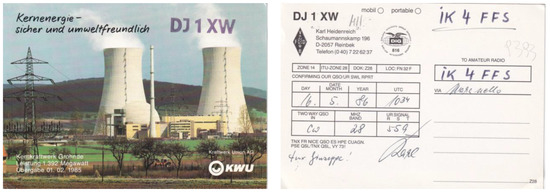
Figure 7.
QSL Card issued by the Kraftwerk Union, featuring KKW Grohnde (KWG) with slogan A. The card, produced for station DJ1 XW shows a personal overprint on the front.
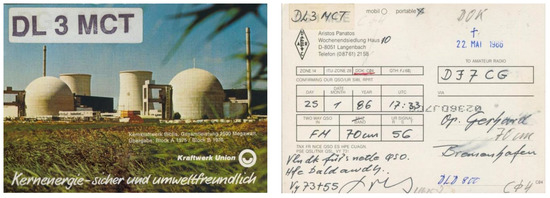
Figure 8.
QSL Card issued by the Kraftwerk Union, featuring KKW Biblis (KWB). The card, produced for station DL3MCT but with errors was listed as DG1MCT.
Some cards seem to support the notion of a separate overprinting process, in particular those that show a generic and blank front, e.g., Emsland, Grohnde and Philippsburg, as well as the card featuring the cardboard model. Of these, the cards featuring nuclear power plants could have easily been designed in a way to offer the free space for the inclusion of the station code on the front. The absence of the prominent station code either represents a shift in attitudes or may simply be a result cost cutting measures as only one side of the card needed to be printed in customized form. One of the cards, with the motif of the nuclear power plant of Emsland, also carries the imprint of Siemens, the parent company of the Kraftwerk Union.
The use of the card motifs by the operators can be set out over time revealing the approximate time that the various designs were released (Figure 9). Based on this seriation, the card motif showing the nuclear power plant of Biblis is the earliest such card, followed by Grafenrheinfeld and Unterweser. Cards with the motif of the powerplant of Brokdorf, are the latest. These dates roughly coincide with the dates when the various nuclear power plants commenced production (Table 1). Exceptions to this rule are Unterweser, Gösgen and Philippsburg. The card featuring the Swiss plant at Gösgen was probably introduced in order to demonstrate that KWU’s commercial activities reached beyond Germany and also to allow it to service international amateur radio operators.
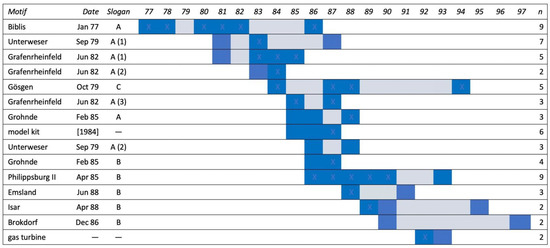
Figure 9.
Chronological seriation of the usage of QSL cards with motifs produced by the Kraftwerk Union. Dark shading shows documented years of usage; light shading inferred years of usage. A number added to the slogan indicates a design variant of the logo (see Figure 6). The date column refers to the commissioning of the nuclear power plant.
5.3. Spatial Distribition
The spatial distribution of the radio stations using QSL cards with motifs of power plants, as well as that of the stations receiving these cards shows a concentration of stations in central western Germany (Figure 10), which corresponds with the areas of highest population density. In addition, QSL cards with motifs of power plants were sent as QSL acknowledgments to not only stations in neighboring countries (Belgium, France, Italy, Serbia and Spain), but also to Australia, Mexico and the USA. It should be noted that the apparent distribution of both the senders and recipients of the QSL cards is skewed due to the geopolitical realities at the time. The fact that the area of the then DDR, as shown as a light shading in Figure 10 shows almost no stations is due to the fact that personal ownership of UHF units was prohibited in the DDR until the reunification of Germany in October 1990. Until the end of 1989 only state authorized and state-controlled community-based amateur stations were permitted to operate, such as the station associated with the Greifswald plant (Figure 1F).
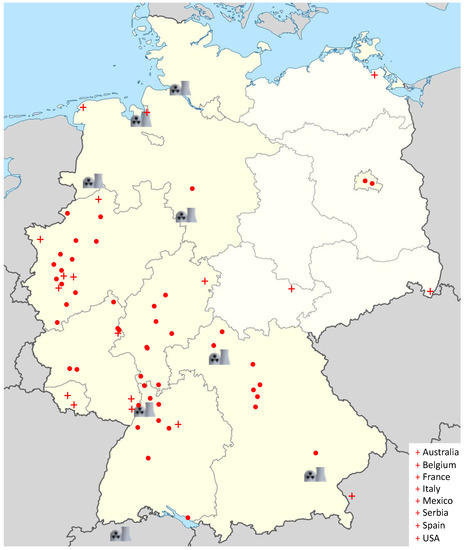
Figure 10.
Geographic distribution of KWU-sponsored QSL card motifs in relation to the nuclear power plants depicted. Circles: locations of radio stations using QSL cards with motifs of power plants; crosses: stations receiving these cards.
While it can be posited that radio operators living in the ‘catchment area’ of nuclear power plants might favor cards with motifs of that specific plant, the distribution of documented cards does not bear this out. While there is a seemingly broad correlation for the cards bearing the motif of the Grafenrheinfeld plant (Figure 11), this is not evident for Biblis (Figure 12) and Unterweser (Figure 13). Moreover, the absence of stations in northern and south-eastern Germany on the Grafenrheinfeld plot (Figure 11) is in fact represented in the overall distribution (Figure 10). This suggests that the operators themselves may have had little influence over which motifs they received.
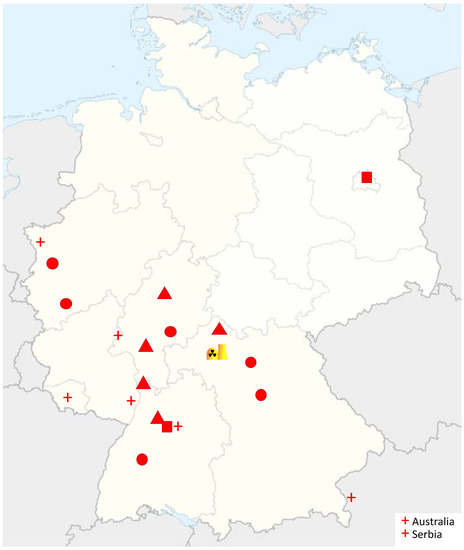
Figure 11.
Geographic distribution of radio stations using KWU-sponsored QSL cards with the motif of the Grafenrheinfeld nuclear power plant.; Circles: stations using QSL cards, design A; squares: stations using QSL cards, design B; triangles: stations using QSL cards, design C; cross: stations receiving these cards.

Figure 12.
Geographic distribution of radio stations using KWU-sponsored QSL cards with the motif of the Biblis nuclear power plant. Circles: locations of radio stations using QSL cards with motifs of power plants; crosses: stations receiving these cards.
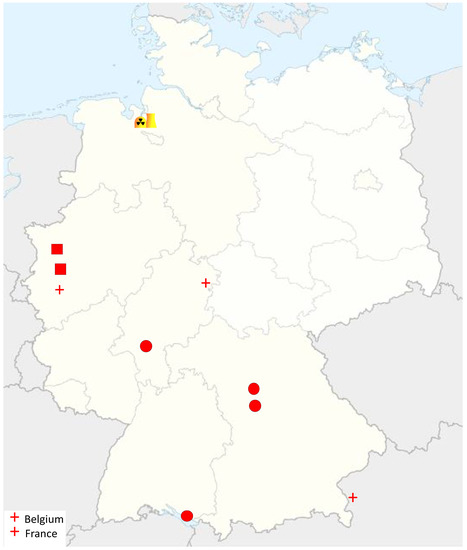
Figure 13.
Geographic distribution of radio stations using KWU-sponsored QSL cards with the motif of the Unterweser nuclear power plant. Circles: stations using QSL cards, design A; squares.
6. Pro-Nuclear Messaging on QSL Cards
As noted earlier, the political climate in Germany in the mid-1970s was characterized by pro- and anti-nuclear sections of the populace. While the energy benefits provided by nuclear power were not doubted, the safety of nuclear power stations and the associated short-term and long-term impact on the environment were hotly contested. As noted, the late 1970s had seen the rise of the anti-nuclear movement with large public protests at the construction sites of the nuclear power plants of Grohnde and Brokdorf (both 1977), as well as the proposed nuclear storage facility at Gorleben (1980) [93,94,95]. The populace was, by and large, not only divided along ideological lines, but also along demographics, with the anti-nuclear movement drawing most of its members from a young, better educated and socially aware demographic.
As community opinion began to swing away from an uncritical acceptance of nuclear power generation [96], the nuclear industry was concerned that that the anti-nuclear and environmental movement might gain traction among older generations. The KWU, as well as the energy companies, were concerned that the emerging environmental sentiment might empower environmental political parties such as the Greens [97,98].
The production of the cards, together with the slogans printed on them, formed part of a public image management strategy by KWU commencing in 1977. Using subliminal advertising, the KWU-produced QSL cards were an attempt to shape the opinion of a specialized segment of German society, the technically oriented mindset of the amateur radio community, in favor of nuclear energy at a time when the industry was coming under increasing pressure from the environmental movement.
The very fact that these cards were produced in the first place shows the desperate need for positive public exposure as perceived by KWU in the late 1970s. Why would a large commercial operator such as KWU, who was only remotely connected with the amateur radio community (as a source of electricity), become involved with providing QSL cards and providing them for free? It appears that this was largely, if not solely due to the initiative and personal interest of an amateur radio interested individual, Karl-Maria Heimberg (DD4NC), who worked for the KWU as an economist and who collaborated on this project with the marketing division of KWU [86].
The publication of these cards was advertised and discussed in amateur radio publications such as CQDL. Much of the awareness of availability, however, was obtained by word of mouth between amateur radio operators [85] with some club station operators recalling that these cards were very actively promoted by some individuals connected with KWU [88]. On the whole the ‘market’ for KWU-produced cards was quite small, both in terms of the number of operators who would use them, and in terms of the number of operators who would receive them. While the annual usage of such cards would of course vary depending on a user’s interest and commitment, recollections by users suggest that, in the main, about 500 cards of a single motif would have been produced per individual amateur [85]. Some operators were able to draw on more than one allocation (but with different motifs). The maximum number of cards that could be obtained by a single user was limited to 2000, while club stations and special events stations could obtain 4000 [86]. Karl-Maria Heimberg (DD4NC) who handled the production and distribution of the cards for KWU recalled that the interest in these cards was sizeable and that between 100,000 and 250,000 units were printed of each one of the card designs [86,87]. It appears that expressions of interests by radio operators were collected until such time that a new edition, to the tune of 50,000 or 100,000 cards became viable. If these numbers are correct, then the known number of cards only represents a very small fraction.
One could assume a geographic correlation between the nuclear power plants shown on the QSL cards and the location of the amateur radio station. While this holds true for the individually produced cards (Figure 1), this was far from the case for the KWU-sponsored cards. In fact, none of the KWU cards illustrated in this study show any correlation (Figure 10). The uptake of the cards occurred in the main by private individuals, but also by radio clubs. Based on recollections of radio operators, the station owner ordering the cards had no influence over which motif was delivered [85]. Indeed, some of the cards were ordered by international users, at least one of them from as far away as Australia [86]. Some operators were able to source multiple issues. Setting aside the owner of DD4NC, who handled the production and distribution of the cards for KWU (6 motifs), and his wife DG1NAS (3 motifs), we have on record five other operators (DF0BT, DK5ZO, DL0MR, DL2NAO and DL5QT) who had secured two motifs each [47].
The use of these KWU-sponsored cards by private individuals, but especially by club stations, was publicly criticized on air, in letters to club media and later also in on-line bulletin boards (see below). This led to some disquiet among club station members. Indeed, one QSL card, featuring KKW Philippsburg, produced for the UHF context group at station DK0VKG, has part of the slogan struck out by the operator on a QSL which was sent out in October 1993, while another with the same image, dated to October 1987, was sent unmodified (Figure 14).
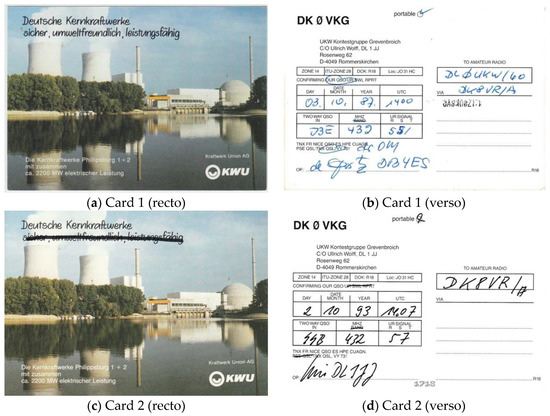
Figure 14.
QSL Cards produced by the Kraftwerk Union for station DK0VKG, featuring KKW Philippsburg (KKP) with slogan B. (a,b) 3 October 1989, (c,d) 2 October 1993 (Image scans courtesy Eugen Düpre).
Earlier, it was noted that the cards were printed with two different slogans: “Kernenergie—sicher und umweltfreundlich” (‘Nuclear energy—safe and environmentally friendly’; Slogan A) and “Deutsche Kernkraftwerke—sicher, umweltfreundlich, leistungsfähig” (‘German nuclear power plants—safe, environmentally friendly, efficient’; Slogan B). The slogan text “Sicher, zuverlässig, wirtschaftlich, umweltfreundlich: Deutsche Kernkraftwerke”, similar to that of Slogan B first appeared in mid- to late-1986 in full-page advertisements, in which KWU made reference to Chernobyl but stressed the quality and track record of German technology [99]. The emphasis on German power plants in slogan B can thus be read as a direct reaction to the Chernobyl disaster of 26 April 1986. Suddenly the safety of nuclear power was being questioned on a wide front [100,101] and the energy industry was at pains to try and explain that German nuclear power plants were different [102,103].
At the time of writing, no QSL cards have been identified that carry anti-nuclear power messages either from individual operators, from clubs or from special interest group stations. We know that at least one such (radio) station existed, albeit briefly: Radio Freies Wendland was operated from the occupation site of the Gorleben nuclear end storage facility in May and June 1980 [104,105]. Also, after the clearance of the site by police forces, it had been broadcasting on and off to marshal interest in blocking transport of spent nuclear fuel rods [106].
The absence of openly anti-nuclear messages on QSL cards can be explained in two ways. On the one hand, amateur radio operators tend to be more technically minded and, on the whole, appear to be less environmentally active. Secondly, and more significantly, amateur radio is supposed to be an apolitical endeavor, even though there are QSL cards from environmental activist groups such as Greenpeace [107]. While politics are regarded as a taboo topic on the amateur radio networks [108,109,110], such ethical standards are not legally binding. The current legislation governing German amateur radio, the Amateurfunkgesetz, prohibits commercial use, but does not specifically exclude political messaging [111]. The executing regulations (‘Amateurfunkverordnung’) are also silent on the matter [112]. The legislation that was applicable at the time, however, the Amateurfunkgesetz §1(2) of 14 March 1949 defined a radio amateur as someone who engages in radio operations for reasons other than economic or political ones [113]. The executing regulations, however, while specific in many other respects, do not comment on the exclusion of political messages [114,115].
The amateur radio scene was divided on the use of the KWU-supplied QSL cards. Some detested the use of any commercially provided cards, but most radio operators did not object to cards manufactured by companies directly associated with the hobby, such as those produced by the German battery manufacturer VARTA (Figure 15).
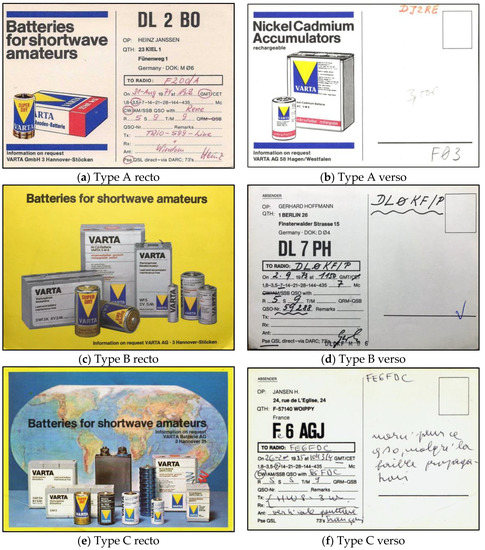
Figure 15.
Examples of QSL Cards produced by VARTA (Source: online auctions).
The KWU-produced cards with nuclear power plants were another matter, presumably as ideological undercurrents introduced into the debate. Their use was publicly criticized on air and in letters to club media [45]. In 1987 and early 1988, one of the QSL managers, reputedly empowered by her local district [116], refused to relay cards with a KWU motif, returning the card with a bilingual sticker stating that “QSLs with AKW-motiven werden nicht vermittelt von I52 Widukind” (QSLs with atomic-pile-motives [sic] will not be managed by I52 Widukind) [117], which brought about a series of arguments relating to the permissibility and desirability of politically charged motifs on QSL cards [118,119,120,121,122]. In particular it was debated, to what extent the §1(2) Amateurfunkgesetz of 14 March 1949, which defined a radio amateur as someone who engages in radio operations for reasons other than economic or political ones [113], applied to images on QSL cards [120,123,124,125,126] or whether the German Amateur Radio Club (DARC) should have, or apply, its own regulations [124,126]. The debate seems to have ended without a solution being found.
7. Conclusions
The QSL cards discussed in this paper intersect three thematic areas of heritage: heritage of picture postcards; the history and heritage shortwave and amateur radio; and the history and heritage of nuclear power generation.
The current state of research into the heritage of shortwave and amateur radio has been discussed in detail in Section 1.2. The conceptualization of that heritage has so far been defined primarily by concerns about the collection and preservation equipment and associated technology, as well the historic significance of selected operations and operators. This is because that the connections established by and the networks set up by individual operators are inherently ephemeral, unless they are recorded. QSL cards, although classed as paper-based ephemera themselves, are a tangible manifestation of such connections. Collections of QSL cards received by individual operators represent nodes in a network and can, collectively, allow for a historical diachronic analysis of informal communications networks. The distribution of the senders and receivers of the QSL cards described in this paper, for example, demonstrates contemporary realities through the exclusion of the then Soviet Bloc countries (Figure 10). As, on a different level, none of the heritage studies have examined what the iconography represented on the QSL cards, this discussion of the QSL cards produced by the nuclear power industry provides a pilot study in that regard.
While the value and cultural heritage significance of picture postcards is a well-established field of academic enquiry [1,5,7,9,10], in particular in colonialism studies [2,3,6,8,11,12], QSL cards, as a specific subset, have seen no serious attention to date. Fruitful areas of future investigation are their chrono-spatial patterning, particularly in terms their iconography. Further, as a specialized and individualized subset of postcard-type imagery, QSL cards allow for the comparison of personal preferences contrasted with the preferences of the public as perceived by commercial publishers. This paper has made a start in that regard.
The history of the nuclear power industry and the heritage significance of nuclear power stations has been commented on in a number of papers [127,128,129,130,131], as has some of the material culture associated with these power plants [47,90,91] and that of the anti-nuclear movement [132,133]. By and large, however, the tangible heritage of that industry is not being preserved, as most decommissioned powerplants are being built back to greenfield sites.
Nuclear power plants as motifs on QSL cards fall into two groups. One group are the cards produced by individual operators highlighting key features of their locality, signaling their own association with the depicted plant, or highlighting the official association of the radio club with the manufacturer (in the case of the BBC cards, for example). These are, in principle, reflections of standard usage concepts. The other group are the cards produced by KWU. They represent a formal and large-scale, marketing-driven approach by a commercial operator, only remotely connected with the amateur radio community, to shape public opinion in favor of nuclear energy at a time when the industry was coming under increasing pressure from the environmental movement.
Funding
The initial data gathering and conceptualization of the study had been funded as part of Charles Sturt University’s internal Special Studies Program for 2014.
Institutional Review Board Statement
Not applicable.
Informed Consent Statement
There are no ethical considerations to report for this paper.
Data Availability Statement
Not applicable.
Acknowledgments
I would like to express my gratitude to the following collectors and amateur radio operators for a number of image scans of QSL cards presented in this study: Fritz Bensberg (Duisburg, Germany), Mal Brooks (Bayswater [Vic], Australia), Eugen Düpre (Heusweiler, Germany), Hans-Hermann Eilts (Norden, Germany), Wolf Harranth (Dokumentationsarchiv Funk, Vienna, Austria), Karl-Maria Heimberg (Uttenhofen, Germany), Karl Koffler (Schifferstadt, Germany), Karlheinz Krümmer (Greifswald, Germany), Karl-Heinz Schirmer (Norden, Germany), Johanna and Achim Schöneberg (Einbeck, Germany), Dieter Teigel (Münster, Germany) and to Hardy Zenker (Greifswald, Germany). I am further indebted to Wolfgang Bleckmann (Duisburg, Germany), and especially to Karl-Maria Heimberg (Uttenhofen, Germany) for background information on how the KWU-produced QSL cards were distributed in the 1980s.
Conflicts of Interest
The author declares no conflict of interest.
References
- Spennemann, D.H.R. The evidentiary value of late nineteenth and early twentieth century postcards for heritage studies. Heritage 2021, 4, 1460–1496. [Google Scholar] [CrossRef]
- Kahn, M. Postcards from Tahiti: Picturing France’s colonial agendas, yesterday and today. In Cultures Through the Post: Essays on Tourism and Postcards; Morgan, N., Robinson, M., Eds.; Channel View: Clevedon, UK, 2005. [Google Scholar]
- Kahn, M. Tahiti intertwined: Ancestral land, tourist postcard, and nuclear test site. Am. Anthropol. 2000, 102, 7–26. [Google Scholar] [CrossRef]
- Prochaska, D. Fantasia of the phototheque: French postcard views of colonial Senegal. Afr. Arts 1991, 24, 40. [Google Scholar] [CrossRef]
- Quanchi, M. Postcards from the colonies: Are postcards valuable as historical evidence? Ozhistorybytes 2004, 4, 60070473. [Google Scholar]
- Hoskins, J. Postcards from the Edge of Empire: Images and messages from French Indochina. SPAFA J. 2008, 18, 16–17. [Google Scholar]
- Il Pai, H. Staging ‘Koreana’ for the Tourist Gaze: Imperialist Nostalgia and the Circulation of Picture Postcards. History Photogr. 2013, 37, 301–311. [Google Scholar] [CrossRef]
- Burns, P. Six postcards from Arabia: A visual discourse of colonial travels in the Orient. Tour. Stud. 2004, 4, 255–275. [Google Scholar] [CrossRef]
- Vanderwood, P.J. The Picture Postcard as Historical Evidence: Veracruz, 1914. Americas 1988, 45, 201–225. [Google Scholar] [CrossRef]
- Spennemann, D.H.R. The Imagery of Postcards sold in Micronesia during the German Colonial Period. Micron. J. Human. Soc. Sci. 2006, 5, 345–374. [Google Scholar]
- Wehbe, R. Seeing Beirut through Colonial Postcards: A Charged Reality; Department of Architecture and Design: Beirut, Lebanon, 2006. [Google Scholar]
- Prochaska, D. Thinking postcards. Vis. Resour. 2001, 17, 383–399. [Google Scholar] [CrossRef]
- Spennemann, D.H.R. A startling impression of orderly picturesqueness. In A Visual Data Set of American Fan Palms (Washingtonia Spp) Depicted on Early Twentieth Century Postcards; Institute for Land, Water and Society Report Institute for Land, Water and Society, Charles Sturt University: Albury, Australia, 2020. [Google Scholar]
- ITU. Radio Regulations. In ITU-R Recommendations Incorporated by Reference; International Telecommunications Union: Geneva, Switzerland, 2012. [Google Scholar]
- Bainbridge, K. QSL Cards, are yours just boring? Amat. Radio 2015, 83, 6–8. [Google Scholar]
- Larsen, J. Picturing Bornholm: Producing and Consuming a Tourist Place through Picturing Practices. Scand. J. Hosp. Tour. 2006, 6, 75–94. [Google Scholar] [CrossRef]
- Markwick, M. Postcards from Malta. Image, Consumption, Context. Ann. Tour. Res. 2001, 28, 417–438. [Google Scholar] [CrossRef]
- Corkery, C.K.; Bailey, A.J. Lobster is big in Boston: Postcards, place commodification, and tourism. GeoJournal 1994, 34, 491–498. [Google Scholar]
- Craglietto, C. I3CRW: 60 Years of Radio and Mountains. A Personal Story in 239 QSLcards. Available online: https://www.dxzone.com/dx27394/i3crw-60-years-of-radio-and-mountains.html (accessed on 4 December 2020).
- Wikipedia. QSL Card. Available online: http://en.wikipedia.org/wiki/QSL_card (accessed on 1 November 2020).
- Johansson, J. The Early Days of Radio in Sweden, Ernst F.W. Alexanderson and Grimeton radio station SAQ, UNESCO World Heritage. In Proceedings of the 7th European Conference on Antennas and Propagation (EuCAP), Gothenburg, Sweden, 8–12 April 2013; pp. 3148–3152. [Google Scholar]
- Walde, C.-H. SAQ in Grimeton, the only remaining pre-electronic transmitter for transatlantic work and the only radio station on the UNESCO World Heritage List. In Wireless World: One Hundred Years since the Nobel Prize to Guglielmo Marconi; Grandin, K., Mazzinghi, P., Olander, N., Pelosi, G., Eds.; Firenze University Press: Firenze, Italy, 2012; pp. 286–301. [Google Scholar] [CrossRef]
- Lopez, J.M.R. The first Spanish Short Wave Stations: Development of radio & TV technology. In Proceedings of the 2010 Second Region 8 IEEE Conference on the History of Communications, Madrid, Spain, 3–5 November 2010; pp. 1–5. [Google Scholar]
- Perkins, J. ‘Germany calling’: Nazi short-wave broadcasting to Australia in the 1930s. J. Aust. Stud. 1994, 18, 43–50. [Google Scholar] [CrossRef]
- Graves, H.N., Jr. Propaganda by Short Wave: London Calling America. Public Opin. Quart. 1941, 5, 38–51. [Google Scholar] [CrossRef]
- Graves, H.N., Jr. Propaganda by Short Wave: Berlin Calling America. Public Opin. Quart. 1940, 4, 601–619. [Google Scholar] [CrossRef]
- Laurie, C.D. Goebbels’s Iowan: Frederick W. Kaltenbach and Nazi Short-Wave Radio Broadcasts to America, 1939–1945. Ann. Iowa 1994, 53, 219–245. [Google Scholar] [CrossRef]
- Hitchcock, M. Making Waves: Admiral Mountbatten’s Radio SEAC 1945–1949. In Helion Studies in Military History 6; Helion & Company: Amherst, Warwick, 2014. [Google Scholar]
- Burns, M. A short wave to globalism: Radio Australia Online. J. Aust. Stud. 2008, 32, 335–347. [Google Scholar] [CrossRef]
- Desmond, R.W.; Olson, K.E.; Eirabie, A.G. Radio Pakistan: Voice of a New Nation. J. Mass Commun. Quart. 1954, 31, 61. [Google Scholar]
- Smulyan, S. Live from Waikiki: Colonialism, race, and radio in Hawaii, 1934–1963. Hist. J. Film Radio Telev. 2007, 27, 63–75. [Google Scholar] [CrossRef]
- Brown, M. Radio magazines and the development of broadcasting: Radio broadcast and radio news, 1922–1930. J. Radio Stud. 1998, 5, 68–81. [Google Scholar] [CrossRef]
- Hedberg, S.B. The Army Amateur Radio System: 1925–1941; School of Advanced Military Studies, United States Army Command and General Staff College: Leavenworth, Kansas, 2010. [Google Scholar]
- Bartlett, R.A. The World of Ham Radio, 1901–1950: A Social History; McFarland: Jefferson, NC, USA, 2015. [Google Scholar]
- Lippmann, S. Boys to men: Age, identity, and the legitimation of amateur wireless in the United States, 1909–1927. J. Broadcast. Electron. Media 2010, 54, 657–674. [Google Scholar] [CrossRef]
- Vaillant, D.W. La Police de l’Air: Amateur Radio and the Politics of Aural Surveillance in France, 1921–1940. Fr. Politics Cult. Soc. 2010, 28, 1–24. [Google Scholar] [CrossRef]
- Arceneaux, N. In search of alien aerials: The World War I campaign against amateur radio. J. Hist. 2012, 38, 2–12. [Google Scholar] [CrossRef]
- Schiavone, F.; Esposito De Falco, S. Limits to creative destruction and technologies in practice: The case of ham radio. Technol. Anal. Strateg. Manag. 2016, 28, 60–75. [Google Scholar] [CrossRef]
- Nollet, K.E.; Ohto, H. When all else fails: 21st century Amateur Radio as an emergency communications medium. Transfus. Apher. Sci. 2013, 49, 422–427. [Google Scholar] [CrossRef] [PubMed]
- Coile, R.C. The role of amateur radio in providing emergency electronic communication for disaster management. Disaster Prev. Manag. Int. J. 1997, 6, 176–185. [Google Scholar] [CrossRef]
- Asheville Radio Museum. Radio Wave Wizardry! Come Explore the Magic. Available online: https://www.avlradiomuseum.org (accessed on 15 June 2021).
- AARL. The ARRL Heritage Museum. Available online: http://www.arrl.org/arrl-heritage-museum (accessed on 15 June 2021).
- Antique Wireless Association. Antique Wireless Museum. Available online: https://www.antiquewireless.org/homepage/museum/ (accessed on 15 June 2021).
- Kurrajong Radio Museum. Welcome to the Kurrajong Radio Museum. Available online: https://vk2bv.org/archive/museum/ (accessed on 15 June 2021).
- Harranth, W. QSL-Karten; Spennemann, D.H., Ed.; Dokumentationsarchiv Funk: Wien, Austria, 2014. [Google Scholar]
- Schöneberg, J.; Schöneberg, A. QSL-Karten mit AKW/KKW; Spennemann, D.H., Ed.; QSL: Einbeck, Germany, 2014. [Google Scholar]
- Spennemann, D.H.R. Material Culture of the German Nuclear Industry II: Picture Postcards and QSL Cards; Institute for Land, Water and Society Report 150; Institute for Land, Water and Society, Charles Sturt University: Albury, Australia, 2021. [Google Scholar]
- Kucera, H.; Picard, B.; Pleßke, H.-M. Sammelrichtlinien für die Deutsche Bücherei, die Deutsche Bibliothek und das Deutsche Musikarchiv, 2nd ed.; Deutsche Bücherei & Deutsche Bibliothek: Leipzig, Germany, 1992. [Google Scholar]
- Matthias, A.; Wiechmann, B. Sammelrichtlinien der Deutschen Nationalbibliothek; Deutsche Nationalbibliothek: Leipzig, Germany; Berlin, Germany, 2009. [Google Scholar]
- Landesarchiv Baden-Württemberg. Richtlinien für die Ergänzungsdokumentation im Landesarchiv Baden-Württemberg vom 16; April 2008; Landesarchiv Baden-Württemberg: Stuttgart, Germany, 2008. [Google Scholar]
- Hanke, U.C. Als Archivar im Kernkraftwerk? Aufgaben und Arbeitsweise des Zentralarchivs im KKW Brunsbütte. In Zwischen Analog und Digital-Schriftgutverwaltung als Herausforderung für Archive; Lutz, A., Ed.; Beiträge zum 13. Archivwissenschaftlichen Kolloquium der Archivschule Marburg; Archivschule Marburg: Marburg, Germany, 2009; pp. 235–256. [Google Scholar]
- Elbe, M. Martin Elbes QSL-Seiten. Available online: http://home.wolfsburg.de/elbe/ (accessed on 1 November 2020).
- Wendt, H. Meine QSL-Karten-Sammlung. DLDeutschland. Available online: http://www.dl7sp.de/myqsls/qslselct.php?lg=de&kland=dl&cland=Deutschland&stuk=1440 (accessed on 1 November 2014).
- Koffler, K. Galerie: DL Germany. Available online: http://abload.de/gallery.php?key=cBaYepxy (accessed on 1 November 2020).
- Schnaare, E. QSL-Sammlung. Available online: http://www.df9dd.de/pages/de/qsl-kollektion.php (accessed on 1 November 2020).
- Koffler, K. QSL Sammlung; Spennemann, D.H., Ed.; Karl Koffler: Schifferstadt, Germany, 2014. [Google Scholar]
- Schmitz, M. Schmitz, M.’s Letter to the Editor Regarding Atomkraft auf. QSL-Karten; Assoziation Deutschsprachiger Kurzwellenhörer (ADDX): Mönchengladbach, Germany, 2014. [Google Scholar]
- Dokumentationsarchiv Funk. Dokumentationsarchiv—QSL Collection. Available online: http://www.dokufunk.org/documentary_archive/collections_listings/index.php?CID=8185 (accessed on 1 November 2020).
- Allied High Commission for Germany. Control of Materials, Facilities and Equipment relating to Atomic Energy (Law N° 22). Off. Gaz. Allied High Comm. Ger. 1950, 122–135. [Google Scholar]
- Allied High Commission for Germany. Amending Law n° 22 [Control of Materials, Facilities and Equipment relating to Atomic Energy] (Law N° 53). Off. Gaz. Allied High Comm. Ger. 1951, 822–823. [Google Scholar]
- Allied High Commission for Germany. Amendment Noo 2 to Law no. 22 [Control of Materials, Facilities and Equipment relating to Atomic Energy] (Law No. 68). Off. Gaz. Allied High Comm. Ger. 1951, 1361–1365. [Google Scholar]
- Costa, H. Die Bundesrepublk und die Internationale Zusammenarbeit auf dem Atomgebiet. In Taschenbuch für Atomfragen; Cartellieri, W., Hocker, A., Schnurr, W., Eds.; Festland Verlag: Bonn, Germany, 1959; pp. 17–56. [Google Scholar]
- Pretsch, J. Der erste Plan zur Entwicklung der Atomtechnik im Bundesgebiet. In Taschenbuch für Atomfragen; Cartellieri, W., Hocker, A., Schnurr, W., Eds.; Festland Verlag: Bonn, Germany, 1959; pp. 71–94. [Google Scholar]
- Pollock, D. Reaktorkern und Kontrollsystem des FRM. In FRM. Der Forschungs-Reaktor München. Herausgegeben anlässlich der Übergabe des Reaktorstation Garching des Laboratoriums für technische Physik der Technischen Hochschule München; Maier-Leibnitz, H., Ed.; Verlag Karl Thiemig: München, Germany, 1959; pp. 23–27. [Google Scholar]
- Pabst, M. Die ersten Betriebsjahre. In 40 Jahre Atom-Ei Garching; von Hassel, G., Waschkowski, W., Eds.; Technische Universität: München, Germany, 1997; pp. 49–70. [Google Scholar]
- Reichert, M. Kernenergiewirtschaft in der DDR: Entwicklungsbedingungen, Konzeptioneller Anspruch und Realisierungsgrad (1955–1990); Scripta-Mercaturae-Verlag: St. Katharinen, Germany, 1999. [Google Scholar]
- Hampe, E. Zur Geschichte der Kerntechnik in der DDR von 1955 bis 1962. Die Politik der Staatspartei zur Nutzung der Kernenergie; Hannah-Arendt-Inst. für Totalitarismusforschung: Dresden, Germany, 1996. [Google Scholar]
- Hentschel, G. Kernkraftwerk Rheinsberg—Rückblick auf Errichtung, Betriebsergebnisse und Aufgaben. In Zur Geschichte der Kernenergie in der DDR; Liewers, P., Abele, J., Barkleit, G., Eds.; Peter Lang: Frankfurt, Germany, 2000; pp. 163–220. [Google Scholar]
- Abele, J.; Hampe, E. Kernenergiepolitik der DDR. In Zur Geschichte der Kernenergie in der DDR; Liewers, P., Abele, J., Barkleit, G., Eds.; Peter Lang: Frankfurt, Germany, 2000; pp. 29–90. [Google Scholar]
- UdSSR & DDR. Abkommen zwischen der UdSSR und der DDR. 1965. [Google Scholar]
- Tempel, K.G. Kernenergie in der Bundesrepublik Deutschland. In Historische Entwicklung, Nutzen u. Risiken, d. Kernenergiediskussion in Polit. Parteien u. Gesellschaftl. Gruppen; Landeszentrale für Politische Bildungsarbeit: Berlin, Germany, 1981. [Google Scholar]
- Müller, W.D.; Hossner, R. Jahrbuch der Atomwirtschaft; Handelsblatt Gmbh: Düsseldorf, Germany, 1986; Volume 17. [Google Scholar]
- Brettschuh, W.; Scholten, V. Unser Service für SWR-Kernkraftwerke. Siemens Serv. Rep. 1990, 5–9. [Google Scholar]
- Wolf, H.G. Der Schrott von morgen. Zum Stand der Atomwirtschaft in der Bundesrepublik; Deutscher Taschenbuch Verlag: München, Germany, 1985. [Google Scholar]
- Krieger, H. Das Konvoi-Konzept für Kernkraftwerke. VGB Kraftwerkstechnik. Mitt. VGB Tech. Ver. Grosskraftwerksbetr. 1982, 62, 753–761. [Google Scholar]
- Erdmann, W. Die bautechnische Verwirklichung des Konvoi-Programms bei Kernkraftwerken von 1982 bis 1985. VGB Kraftwerkstechnik. Mitt. VGB Tech. Ver. Grosskraftwerksbetr. 1986, 66, 1089–1093. [Google Scholar]
- Rieser, R.; Kojetinsky, A. Kernkraftwerk Usar 2—Modellanlage des “Konvois”. VGB Kraftwerkstechnik. Mitt. VGB Tech. Ver. Grosskraftwerksbetr. 1983, 63, 1039–1047. [Google Scholar]
- Brosche, D. Das atomrechtliche Genehmigungsverfahren für das Kernkraftwerk Isar 2. Erfahrungen mit der Abwicklung im Konvoi und Folgen des Baustopps. VGB Kraftwerkstechnik. Mitt. VGB Tech. Ver. Grosskraftwerksbetr. 1985, 65, 450–455. [Google Scholar]
- Darge, T. Alte Meiler bleiben am Netz—die Gefahren des AKW Grohnde; Bürgerinitiative Umweltschutz: Hannover, Germany, 2011. [Google Scholar]
- Engels, J.I. Geschichte und Heimat. Der Widerstand gegen das Kernkraftwerk Wyhl. In Wahrnehmung, Bewusstsein, Identifikation: Umweltprobleme und Umweltschutz als Triebfedern regionaler Entwicklung; Kretschmer, K., Ed.; Technische Universität Bergakademie: Freiberg, Germany, 2003; pp. 103–130. [Google Scholar]
- Sinn, D. Kernkraftwerke—Eine Lösung für die Zukunft? Arena Verlag: Würzburg, Germany, 1978. [Google Scholar]
- Klar, D. Kraftwerke und deren Umfeld as Schauplatz von Auseinandersetzungen—Chronik eines Photoreporters. In Neue Energie!? Abschied vom Kernkraftwerk Stade; Frerichs, K., Mettjes, G., Eds.; Verlag H. M. Hauschild: Bremen, Germany, 2004; pp. 120–151. [Google Scholar]
- Müller, W.D.; Hossner, R. Jahrbuch der Atomwirtschaft; Handelsblatt Gmbh: Düsseldorf, Germany, 1982; Volume 13. [Google Scholar]
- Zenker, H. Hardy Zenker’s letter to the editor regarding Kernkraftwerk auf Ihrer QSL Karte; Spennemann, D.H., Ed.; Hardy Zenker: Greifswald, Germany, 2014. [Google Scholar]
- Bleckmann, W. Kernkraftwerk auf Ihrer QSL Karte (Station DG1JY); Spennemann, D.H., Ed.; Bleckmann, Wolfgang: Duisburg, Germany, 2014. [Google Scholar]
- Heimberg, K.-M. Karl-Maria Heimberg’s letter to the editor regarding Kernkraftwerk auf Ihrer QSL Karte; Spennemann, D.H., Ed.; Karl-Maria Heimberg: Uttenreuth, Germany, 2014. [Google Scholar]
- Heimberg, K.-M. QSL Karten mit KWU Motiven; Spennemann, D.H., Ed.; Karl-Maria Heimberg: Uttenreuth, Germany, 2014. [Google Scholar]
- Teigel, D. Teigel, D.’s Letter to the Editor Regarding Atomkraft auf. QSL-Karten; Spennemann, D.H., Ed.; Assoziation Deutschsprachiger Kurzwellenhörer (ADDX): Mönchengladbach, Germany, 2014. [Google Scholar]
- Maier-Leibnitz, H. Auswahl des Reaktortyps und geplante Verwendung. In FRM. Der Forschungs-Reaktor München. Herausgegeben anlässlich der Übergabe des Reaktorstation Garching des Laboratoriums für technische Physik der Technischen Hochschule München; Maier-Leibnitz, H., Ed.; Verlag Karl Thiemig: München, Germany, 1959; pp. 38–39. [Google Scholar]
- Spennemann, D.H.R. Material Culture of the German Nuclear Industry I: Official Paraphernalia; Institute for Land, Water and Society Report 149; Institute for Land, Water and Society, Charles Sturt University: Albury, Australia, 2021. [Google Scholar]
- Spennemann, D.H.R. Material Culture of the German Nuclear Industry III: Industry Marketing Materials; Institute for Land, Water and Society Report 151; Institute for Land, Water and Society, Charles Sturt University: Albury, Australia, 2021. [Google Scholar]
- Pleiner, T. Modell eines Kernkraftwerkes mit Druckwasserreaktor DWR 1300; Bauanleitung; Kraftwerksunion/Siemens AG: Frankfurt am Mein, Germany, 1984. [Google Scholar]
- Wetzels, M. AKW Brokdorf: Bildband zu den Demonstrationen gegen das Kernkraftwerk Brokdorf 1976; epubli GmbH: Berlin, Germany, 2012. [Google Scholar]
- Benedict, H.-J. “Bürgerkrieg” in Brokdorf oder: Von den Schwierigkeiten gewaltfreien Protests. Frankfurter Hefte 1977, 32, 23–30. [Google Scholar]
- Rucht, D. Von Wyhl nach Gorleben. Bürger gegen Atomprogramm und nukleare Entsorgung; Beck: München, Germany, 1980; Volume 222. [Google Scholar]
- Radkau, J. Learning from Chernobyl for the fight against Genetics? Stages and Stimuli of German Protest Movements—A comparative Synopsis. In Resistance to New Technology; Bauer, M., Ed.; Cambridge University Press: Cambridge, UK, 1995; pp. 335–356. [Google Scholar]
- Montanus, K. Die Anti-Atomkraft-Bewegung marschiert. Atom Strom 1979, 25, 65. [Google Scholar]
- Hillerbrand, M. Emotion und Ideologie in Kernenergiestreit. Atom Strom 1982, 28, 121–123. [Google Scholar]
- Kraftwerk-Union. “Sicher, zuverlässig, wirtschaftlich, umweltfreundlich: Deutsche Kernkraftwerke”. In Deutschlandtag 1986, Köln 21–23 November; Bundesgeschäftstelle Junge Union Deutschlands, Ed.; Sator Werbeverlag: Hamburg, Germany, 1986; p. 47. [Google Scholar]
- Paul, R. Der gefährliche Traum: Atomkraft: Nach Tschernobyl: Notwendiges Basiswissen, Daten über Sicherheitsrisiken, Steckbriefe aller deutschen AKWs, Folgen von Tschernobyl und Harrisburg für Mensch und Umwelt; Eichborn: Frankfurt am Main, Germany, 1986; p. 178. Available online: http://d-nb.info/860715604 (accessed on 20 June 2021).
- Veit, B. Wir informieren uns. Atomenergie? Was wir nach Tschernobyl Wissen Sollten, 2nd ed.; F. Schneider: München, Germany, 1986. [Google Scholar]
- Hennies, H.-H. Ablauf, Konsequenzen und Bewertung des Reaktorunfalls in Tschernobyl. VGB Kraftwerkstechnik. Mitt. VGB Tech. Ver. Grosskraftwerksbetr. 1986, 66, 902–909. [Google Scholar]
- Grümm, H. Die Kernenergie nach Tschernobyl. VGB Kraftwerkstechnik. Mitteilungen der VGB Technische Vereinigung der Grosskraftwerksbetreiber 1988, 68, 4–7. [Google Scholar]
- Klein, I. Sendeprotokoll des Radio RFW. In Republik Freies Wendland; Dokumentation, E., Zint, G., Eds.; Zweitausendeins: Frankfurt, Germany, 1980; pp. 203–212. [Google Scholar]
- Mossmann, W. Im Wendland am Räumungstag: Immerzu UKW. In Republik Freies Wendland; Eine, D., Zint, G., Eds.; Zweitausendeins: Frankfurt, Germany, 1980; p. 211. [Google Scholar]
- Radio Freies Wendland. Info-und Aktionsradio zum Castortransport. 2011. Available online: https://linksunten.indymedia.org/node/49861 (accessed on 1 November 2020).
- van Egdom, W. Papa Greenpeace 6 Rainbow Warrior. Available online: http://www.greenpeace.org/international/en/news/Blogs/makingwaves/papa-greenpeace-6-rainbow-warrior/blog/37682/ (accessed on 6 November 2020).
- Devoldere, J.; Demeuleneere, M. Ethik und Betriebshinweise für den Funkamateur, 3rd ed.; International Amateur Radio Union: Newington, CT, USA, 2010. [Google Scholar]
- Devoldere, J.; Demeuleneere, M. Ethics and Operating Procedures for the Radio Amateur, 3rd ed.; International Amateur Radio Union: Newington, CT, USA, 2010. [Google Scholar]
- Devoldere, J.; Demeuleneere, M. Ethics and Operating Procedures for the Radio Amateur, 1st ed.; International Amateur Radio Union: Newington, CT, USA, 2008. [Google Scholar]
- Bundestag. Gesetz über den Amateurfunk. Bundes Gesetzbl. 1997, I, 1494–1496. [Google Scholar]
- Bundesministerium für Wirtschaft und Arbeit. Verordnung zum Gesetz über den Amateurfunk. Bundes Gesetzbl. 2005, I, 242–250. [Google Scholar]
- Wirtschaftsrat. Gesetz über den Amateurfunk. Gesetzbl. Verwalt. Ver. Wirtsch. 1949, 20. [Google Scholar]
- Bundesminister für Post–und Fernmeldewesen. Verordnung zur Durchführung des Gesetzes über den Amateurfunk. Bundes Gesetzbl. 1967, I, 284–289. [Google Scholar]
- Verwaltung für Post-und Fernmeldewesen. Verordnung zur Durchführung des Gesetzes über den Amateurfunk. Gesetzbl. Verwalt. Ver. Wirtsch. 1949, 21–23. [Google Scholar]
- Fietz, B. Fietz, B’s letter to the editor regarding Atomkraft auf QSL-Karten. CQ DL Amat. 1988, 567. [Google Scholar]
- Editor CQ DL. Zur Diskussion gestellt Atomkraft auf QSL-Karten. CQ DL Amat. 1988, 307. [Google Scholar]
- Rose, M. I52 verweigert QSL-Karten. CQ DL Amat. 1988, 307. [Google Scholar]
- Kordsmeyer, P. Peter Kordsmeyer’s letter to the editor regarding Atomkraft auf QSL-Karten. CQ DL Amat. 1988, 439. [Google Scholar]
- Wolfram, G. Günter Wolfram’s letter to the editor regarding Atomkraft auf QSL-Karten. CQ DL Amat. 1988, 439. [Google Scholar]
- Riebesam, H. Harry Riebesam’s letter to the editor regarding Atomkraft auf QSL-Karten. CQ DL Amat. 1988, 439. [Google Scholar]
- Tauchert, G. Werbe-Award. CQ DL Amat. 1988, 633. [Google Scholar]
- Vieth, K.-D. Karl-Dieter Vieth’s letter to the editor regarding Atomkraft auf. QSL-Karten. CQ DL Amat. 1988, 439. [Google Scholar]
- Hecht, E. Ernest Hecht’s letter to the editor regarding Atomkraft auf. QSL-Karten. CQ DL Amat. 1988, 567. [Google Scholar]
- Dreyer, H. Hans Dreyer’s letter to the editor regarding Atomkraft auf. QSL-Karten. CQ DL Amat. 1988, 567. [Google Scholar]
- Feil, H.A. Hans A. Feil’s letter to the editor regarding Atomkraft auf. QSL-Karten. CQ DL Amat. 1988, 567. [Google Scholar]
- Holtorf, C.; Högberg, A. Archaeology and the future: Managing nuclear waste as a living heritage. In Proceedings of the Radioactive Waste Management and Constructing Memory for Future Generations, Proceedings of the International Conference and Debate, Verdun, France, 15–17 September 2014; Organisation for Economic Co-Operation and Development: Paris, France, 2015; pp. 97–101. [Google Scholar]
- Taylor, B.C.; Freer, B. Containing the nuclear past: The politics of history and heritage at the Hanford Plutonium Works. J. Organ. Chang. Manag. 2002, 15, 563–588. [Google Scholar] [CrossRef]
- Gunn, J.B. A unique journey in preserving nuclear industrial heritage. WIT Trans. Built Environ. 2012, 123, 175–186. [Google Scholar]
- Rindzevičiūtė, E. Nuclear energy in Russia: From future technology to cultural heritage. British-Lithuanian Society Tiltas 2016, Summer, 1–6. [Google Scholar]
- Holtorf, C.; Högberg, A. Communicating with future generations: What are the benefits of preserving for future generations? Nuclear power and beyond. Eur. J. Post-Class. Archaeol. 2014, 4, 315–330. [Google Scholar]
- Spennemann, D.H.R. Asterix und das Atomkraftwerk. Bibliographic Forensics of a German Underground Comic; Stichting Laka, Documentatie en Onderzoeks-Centrum Kernenergie: Amsterdam, The Netherlands, 2015. [Google Scholar]
- Spennemann, D.H.R. Keeping it out of the Open. The Production and Collections History of Asterix und das Atomkraftwerk as an example of the liminality of underground literature. Leipz. Jahrb. Für Buchgeschichte 2016, 24, 161–201. [Google Scholar]
Publisher’s Note: MDPI stays neutral with regard to jurisdictional claims in published maps and institutional affiliations. |
© 2021 by the author. Licensee MDPI, Basel, Switzerland. This article is an open access article distributed under the terms and conditions of the Creative Commons Attribution (CC BY) license (https://creativecommons.org/licenses/by/4.0/).